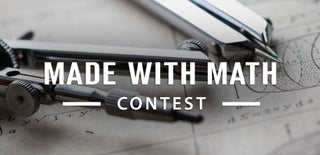Introduction: Tessellations, Hands-on Math
This project is made to give students the opportunity to design there own tessellations and understant the math behind that. Explore the unique feature of "Calçada Portuguesa" a beautiful and useful way to use tessellations.
Supplies
3D printer
Color Filament
Step 1: Design the Polygons
You can use any 3D sotware to design this. I choose Openscad because it's free and very precise.
Let's use this formula:
{circle(20,$fn=8);%circle(20,$fn=90);}
Now you have a 2d shape.
Step 2: Add Volume to Polygons
It's time to add volume so add this line before the previous one:
linear_extrude(height = 3, center = true, convexity = 0)
And you obtain your first polygon
Step 3: Make Other Polygons
You can make different polygons by change the value that apears above the green bar in the next photos.
Now you need to print them!
Step 4: Stl Files and Print Settings
This is my print settings:
Printer: Bq Witbox
Rafts: No
Supports: No
Resolution: 0,2mm
Infill: 20%
Notes: Filament: PLA | Print Speed: 60mm/s | Bed adhesive: hair spray
Step 5: Teacher's Notes
Project Name
Tessellations, hands-on math is made to give students the opportunity to design there own tessellations and understant the math behind that. Explore the unique feature of "Calçada Portuguesa" a beautiful and useful way to use tessellations.
Overview & Background
This project give me more knowledge about math. I was a medium math student and now with 3D printers at a reasonable price it's a great opportunity to everyone knows more about math and have hands on activities in schools.
Objectives
At the end of this project students wil be abble to:
- Identify polygons
- Identify Regular Tessellations
- Identify Semi Regular Tessellations
- Build there own tessellations
Audiences
This project is made for 5th grade
Subjects
Math
Skills Learned
- Math of polygons
- Tessellations
- "Calçada Portuguesa", a brief history
Lesson/Activity
There is a powerpoint you can use as guideline for the activity.
Attachments
Step 6: Classroom Activity - What Is a Polygon?
List of things to get before activity starts:
- Plastic polygons printed or ordered by the teacher
- A media projector and a computer
- Pencil for students
- A webcam or a camera
- A printer
- Glue
- Scissores
- Make groups of 4 or 5 students
What is a polygon?
The teacher should ask first to students if they know what is a polygon. From there the activity should start.
Step 7: Classroom Activity - Identify Polygons
The teacher should give to each student the “Identify polygons” worksheet and let them do the work.
Attachments
Step 8: Classroom Activity - Tessellations
The teacher should now introduce the concept of tessellation. Explain the difference between regular and semi-regular tessellations.
Step 9: Classroom Activity - Identify Regular Tessellations
The teacher should give to each student the “Identify Regular Tessellations” worksheet and let them do the work
Step 10: Classroom Activity - Identify Semi Regular Tessellations
The teacher should give to each student the “Identify SemiRegular Tessellations” worksheet and let them do the work
Step 11: Classroom Activity - Build Your Own Tessellation
The teacher should give to each student the “Build your own Tessellation” worksheet and invite students to use the plastic pieces to make there own tessellations. After that the teacher our the students should use the camera to take a picture of the tessellation, print it and glue it on the worksheet
Step 12: Classroom Activity - "Calçada Portuguesa" a Brief History
From here to end the teacher should tell a little story about "Calçada portuguesa" and show the beautiful images in the powerpoint of this wonderful use of tessellation.

Judges Prize in the
Made with Math Contest




















